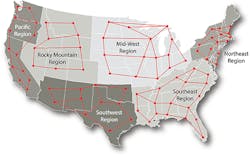Planning Holistically for DCI Evolution —
Growing customer demand is a good problem to have, but for data centers it presents challenges as the amount of traffic passing between geographically dispersed data centers is increasing dramatically. The boom in Cloud services and over-the-top applications is straining data center interconnect (DCI) networks, networks that were planned and designed long before the data revolution began.
One thing we know for sure is that the demand for data is going to continue to grow exponentially, and service providers will continually be tasked with providing faster and more efficient uses of bandwidth. Through a series of mergers and acquisitions, many service providers currently have local, regional, or national data center networks that are connected by a variety of network transport technologies including SONET/SDH, carrier Ethernet, and wavelength-division multiplexing (WDM, CWDM, or DWDM).
Growing demand is straining Data Center Interconnect.
In DCI networks, the primary goal is almost always to increase bandwidth and capacity. Determining how to modernize these networks and the timetable to do it is a daunting task and requires a well-thought-out, comprehensive plan that breaks networks down on a market-by-market or regional basis.
Migration Strategy Options
The maxim "Rome wasn’t built in a day" is highly relevant to DCI network evolution. Developing a phased expansion and modernization road map requires a prudent and pragmatic approach to analyzing the cost and complexity of evolving each network. Factors to consider include awareness of future trends and needs, understanding of both the big picture and the tiny detail, and commitment to conserving capital while reducing waste.
Tackling network modernization for data center transport networks, requires a clear understanding of what goals, obstacles, and limitations must be addressed, and it is not a one-size-fits-all scenario. Service providers need to create a holistic DCI migration plan that takes into consideration the market/technology dynamics for each geographic area of their total network.
There are 3 major approaches to DCI network evolution:
1. Maintaining and expanding the existing technology.
2. Upgrading legacy products to second-generation transport.
3. Replace the network with state-of-the-art technology.
If It Ain’t Broke, Don’t Fix It
Most service providers have some markets that are functioning "just fine as-is" with existing legacy equipment, such as SONET or Digital Cross-Connect Systems (DCS). The networks have enough spare capacity to grow by just adding transponders and the only real obstacle is maintaining network reliability and minimizing hardware failures. This status quo approach maximizes the useful life of existing network assets.
With these legacy transport networks, one of the main challenges service providers face is maintaining spare parts for older technologies that have been deemed end-of-life or manufacturer-discontinued.
A market-by-market viewpoint is as important as seeing the big picture.
While developing their migration strategy for legacy SONET, DCS, and WDM transport networks, service providers evaluate the best way to balance their OpEx and CapEx expenditures while expanding capacity to meet market demands. Deciding on the right time to modernize from first-generation transport, the tipping point derives from the combination of the need for capacity, the lack of physical space for expansion (real estate), and the cost of utilities. Upgrading to second-generation SONET or packet optical networks (carrier Ethernet) lowers costs by substantially reducing floor space, power, and air conditioning requirements, while providing greater capacity at speeds up to 100G over DWDM. Modernization also improves network performance and reliability, gains greater operational efficiencies, decreases the operation and maintenance costs associated with legacy equipment, and reclaims spares that can be used in other areas of the network.
In With the New, Out With the Old
In high-growth markets, service providers want forward-looking technologies for DCI that are agile, flexible, and programmable, and offer high-speed services over DWDM at 100G or 200G rates and beyond. This requires a major network upgrade that replaces the legacy equipment.
The selection of network hardware and software is critical. SDN/NFV and open control interfaces are clearly growing forces in the evolution of transport networks. The combination of software-defined networking (SDN) controllers, open interfaces (such as NETCONF and YANG) and network function virtualization (NFV) leads to more automation and multivendor control that spans multiple network layers. This, in turn, creates smarter and more flexible networks versus static pipes. For service providers, this will reduce CapEx and OpEx and enable faster time to market for new services.
When selecting next-generation platforms, service providers have more flexibility and greater freedom of choice in planning their networks. It is now much easier to combine multiple vendors’ equipment and software into a single network, and determine just how open you want the network to be. The choice of blade-versus-chassis hardware platforms opens up an additional level of flexibility. Blade-based disaggregated platforms offer pay-as-you-grow financial flexibility by helping to target equipment investments exactly where most needed. All these factors enable service providers to select best-of-breed products for individual functions. A network designed to these paradigms will be flexible and drive down cost.
Once all the decisions are made, an overlay network is constructed and the traffic is migrated from the legacy network to the new infrastructure. The new transport network provides significant costs savings through the reduction of both power and space versus the legacy technology. A bonus is that the decommissioned legacy equipment can be redeployed in another region of the network.
Creating the Right Combination for Your Network
Although a holistic approach to planning DCI network evolution is essential to a successful outcome, from an execution standpoint the plan is best carried out on a market-by-market basis. This approach not only breaks the process down into manageable steps, it can parlay into saving a lot of money. For instance, placing decommissioned equipment from one site into spares inventory enables this equipment to be used as donated organs that preserve networks in other locations. This type of approach can help to control or adjust timing, spread the cost of modernization, reduce waste, and save money by extending the useful life of revenue-generating assets.
A pre-owned equipment supplier can help service providers overcome obstacles by supplying hard-to-find discontinued parts. Pre-owned suppliers can also help minimize risk by testing equipment so that it can be placed in spares inventory with assurance that it is in working order.
Developing a logical, comprehensive DCI migration strategy that encompasses these tactics is crucial to a profitable outcome meeting burgeoning demand in the data center market segment. Network evolution/modernization is not a one-size-fits-all undertaking, and it is unlikely to be successful without a clear understanding of the goals and obstacles involved. Additionally, finding ways to eliminate waste, such as by reusing equipment that might normally be discarded, can bring hidden savings potential into the light of day.
Save
Save







